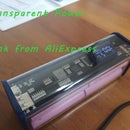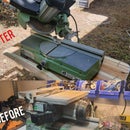Introduction: Fix Your Cordless Tool Battery
Why can't our batteries last forever?
Why can't our cheap batteries be as good as the original ones, and be as reliable as we're used to?
Do we need to throw away new battery that shows low voltage just after one use?
With the first two, the answer is, probably, that's the way it is. And it's definitely my fault buying cheap batteries...
For the last one, the answer is NO. And I'll show you how to fix it today.
(Or, buy cheap battery and fix it right away...)
Supplies
You must already have most of the basic stuff I'm using here, hand tools and such, we all do DIY here...
For the other things I use Banggood, they have been good to me over the years with great prices and customer service, can't recommend them enough.
Here's the fancy list:
- Spot welder, I'm using and old version of this, and used this one in the past, also don't buy this.
- Soldering iron, this one is a good option. I bought it several years ago, and it was solid since.
- Multi-meter, you must have several at home, and don't need any links from me. In case you do, I'm using this one, compact yet convenient.
Step 1: Open Your Battery and Locate the Faulty Cell
Your battery is probably held together by several bolts. Get the appropriate tool and disassemble the case.
Then using your multi-meter go and check the voltage of each cell, the math goes something like this:
Lithium cells (useful ones) are always between ~3.2 and 4.2 volts, with nominal value of 3.6 or 3.7.
This means that a typical 5cell tool battery (most of them are 5cells) is between ~16 and 21 volts.
If you have something lower than 16 volts, than you have a dead cell and your charger won't be able to charge the battery. In my case I had one below 0.5v !! This is the one we're going to replace.
Step 2: Cut the Cell Out and Insert a New One
Once the bad cell is located, carefully cut the tabs and push it out of it's plastic case.
Take care of the circuit board, you will need it for the battery to function later.
Now, and this is important, find a good cell (double check, ask me how I know) and push it instead of the dead one.
The actual capacity is not very important (especially for these cheap batteries), I had this Samsung cell (the pink one) and it's around 2000mAh. So as long as you're around that you're good.
Step 3: Weld and Solder the New Cell
Here we're using nickel strips and connect the newly added cell to the whole battery.
I'm using a small spot welder for this, and later a soldering iron to solder the leads to the nickel strips.
I can't advocate buying a fancy spot welder for the occasional mending, but a small (and cheap) unit like this is useful and a good investment IMO. Plus it's lots of fun watching the sparks fly from the welds (just use eye protection).
Step 4: Final Check and Close Your Battery
Do yourself a favor and go over the battery with the multi-meter one more time. You want to make sure the battery is fixed before closing.
Then just do the same as in opening but in reverse order. You've got yourself a battery which will serve you better (than the one in the beginning, with the bad cell)
Enjoy,
Dani













